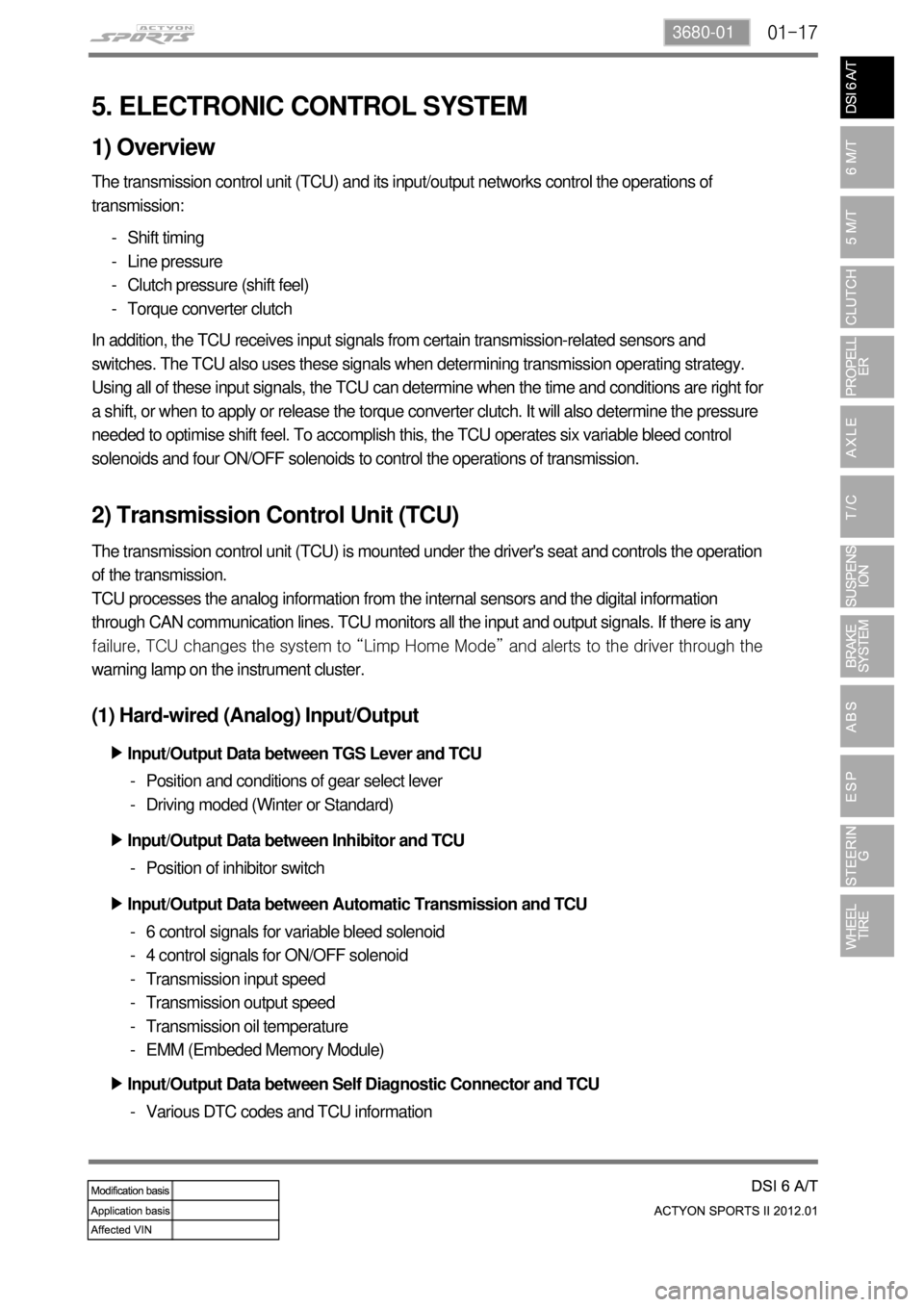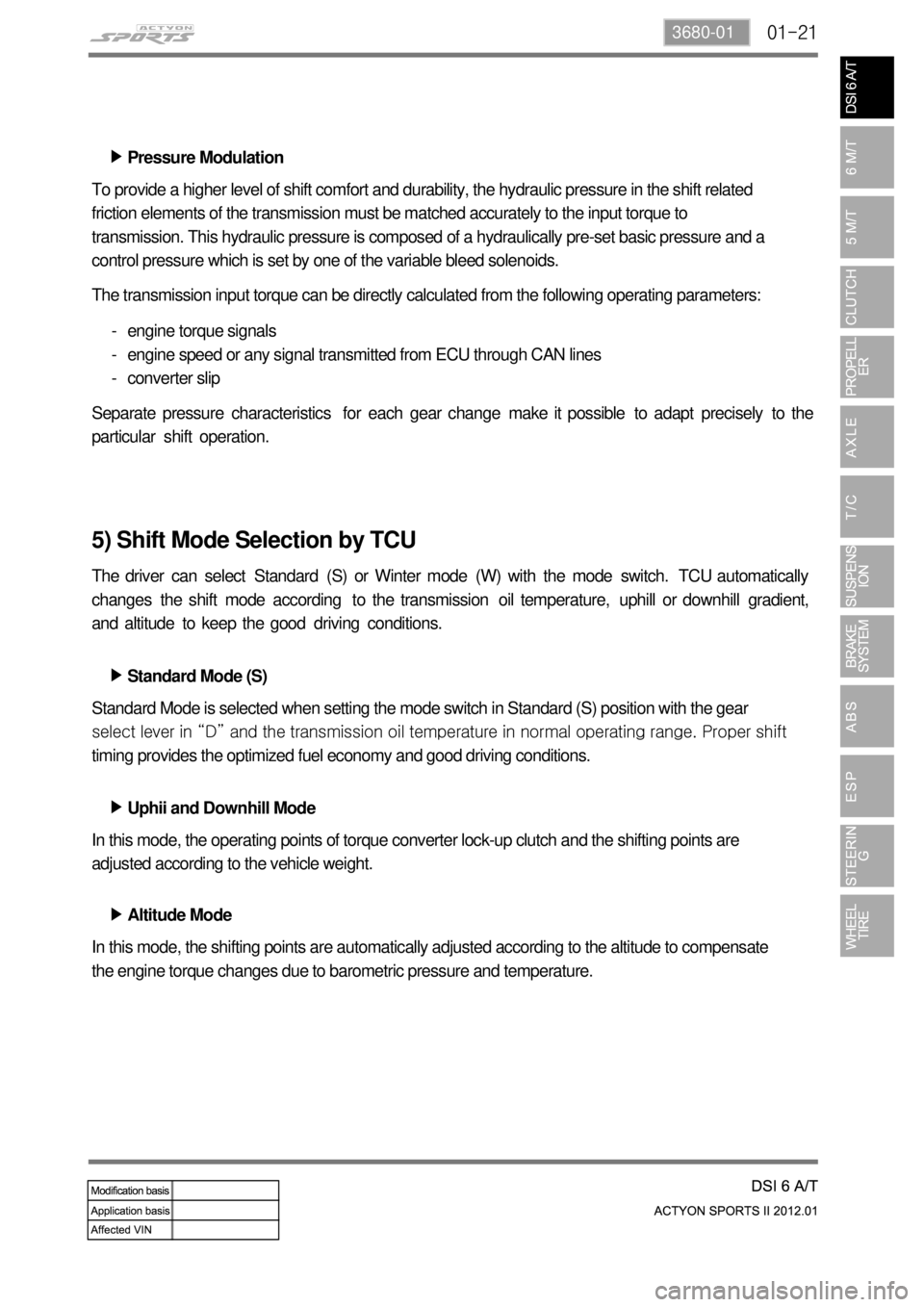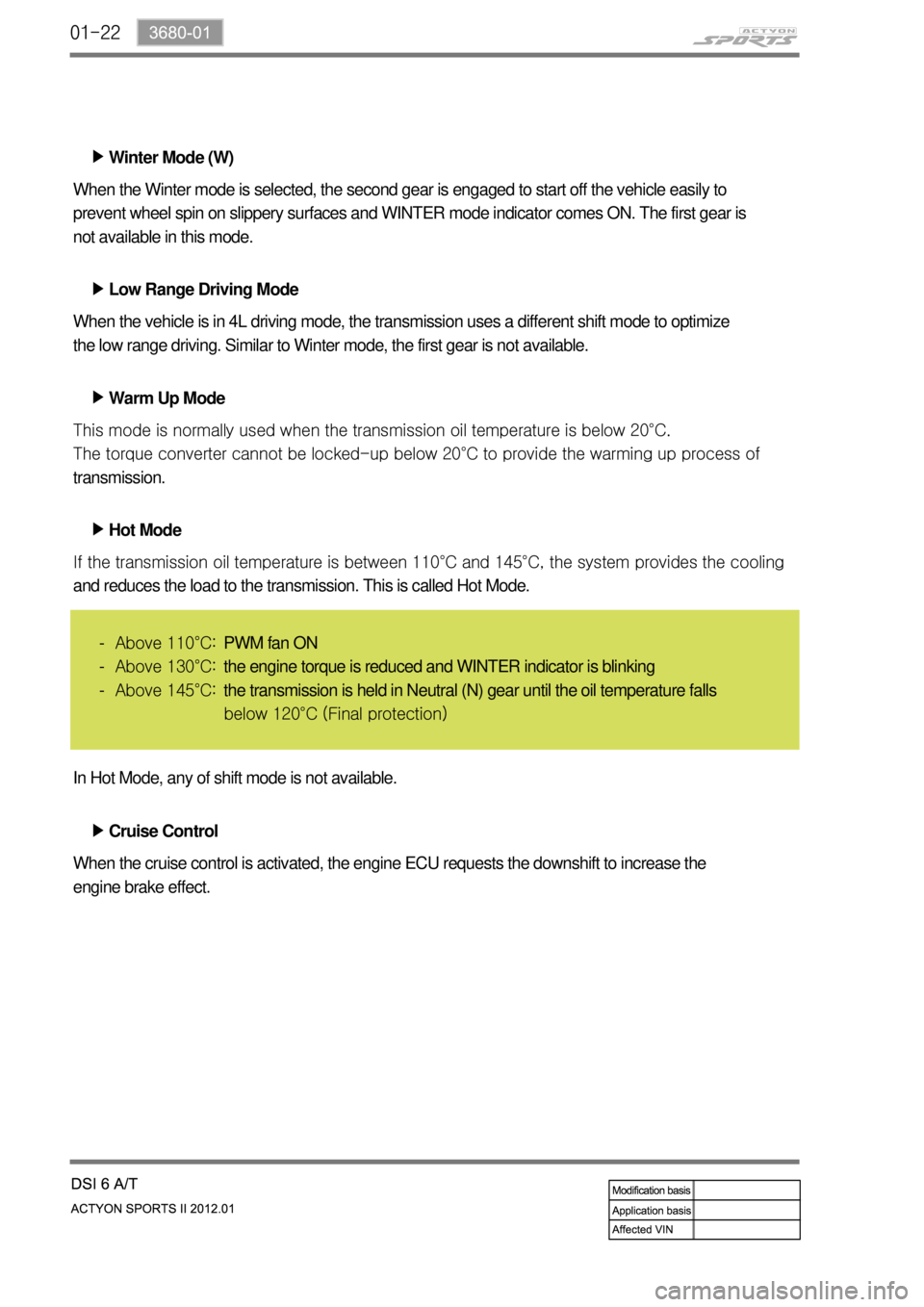Page 561 of 828

01-173680-01
5. ELECTRONIC CONTROL SYSTEM
1) Overview
The transmission control unit (TCU) and its input/output networks control the operations of
transmission:
Shift timing
Line pressure
Clutch pressure (shift feel)
Torque converter clutch -
-
-
-
In addition, the TCU receives input signals from certain transmission-related sensors and
switches. The TCU also uses these signals when determining transmission operating strategy.
Using all of these input signals, the TCU can determine when the time and conditions are right for
a shift, or when to apply or release the torque converter clutch. It will also determine the pressure
needed to optimise shift feel. To accomplish this, the TCU operates six variable bleed control
solenoids and four ON/OFF solenoids to control the operations of transmission.
2) Transmission Control Unit (TCU)
The transmission control unit (TCU) is mounted under the driver's seat and controls the operation
of the transmission.
TCU processes the analog information from the internal sensors and the digital information
through CAN communication lines. TCU monitors all the input and output signals. If there is any
<008d008800900093009c0099008c00530047007b006a007c0047008a008f00880095008e008c009a0047009b008f008c0047009a00a0009a009b008c00940047009b0096004702c800730090009400970047006f00960094008c004700740096008b008c02
c9004700880095008b004700880093008c0099009b009a0047>to the driver through the
warning lamp on the instrument cluster.
(1) Hard-wired (Analog) Input/Output
Input/Output Data between TGS Lever and TCU ▶
Position and conditions of gear select lever
Driving moded (Winter or Standard) -
-
Position of inhibitor switch - Input/Output Data between Inhibitor and TCU ▶
6 control signals for variable bleed solenoid
4 control signals for ON/OFF solenoid
Transmission input speed
Transmission output speed
Transmission oil temperature
EMM (Embeded Memory Module) -
-
-
-
-
- Input/Output Data between Automatic Transmission and TCU ▶
Input/Output Data between Self Diagnostic Connector and TCU ▶
Various DTC codes and TCU information -
Page 565 of 828

01-213680-01
Pressure Modulation ▶
To provide a higher level of shift comfort and durability, the hydraulic pressure in the shift related
friction elements of the transmission must be matched accurately to the input torque to
transmission. This hydraulic pressure is composed of a hydraulically pre-set basic pressure and a
control pressure which is set by one of the variable bleed solenoids.
The transmission input torque can be directly calculated from the following operating parameters:
engine torque signals
engine speed or any signal transmitted from ECU through CAN lines
converter slip -
-
-
Separate pressure characteristics for each gear change make it possible to adapt precisely to the
particular shift operation.
5) Shift Mode Selection by TCU
The driver can select Standard (S) or Winter mode (W) with the mode switch. TCU automatically
changes the shift mode according to the transmission oil temperature, uphill or downhill gradient,
and altitude to keep the good driving conditions.
Standard Mode (S) ▶
Uphii and Downhill Mode ▶
Altitude Mode ▶ Standard Mode is selected when setting the mode switch in Standard (S) position with the gear
<009a008c0093008c008a009b00470093008c009d008c0099004700900095004702c8006b02c9004700880095008b0047009b008f008c0047009b009900880095009a00940090009a009a00900096009500470096009000930047009b008c00940097008c00
990088009b009c0099008c0047009000950047009500960099>mal operating range. Proper shift
timing provides the optimized fuel economy and good driving conditions.
In this mode, the operating points of torque converter lock-up clutch and the shifting points are
adjusted according to the vehicle weight.
In this mode, the shifting points are automatically adjusted according to the altitude to compensate
the engine torque changes due to barometric pressure and temperature.
Page 566 of 828

01-22
Winter Mode (W) ▶
Low Range Driving Mode ▶
Warm Up Mode ▶ When the Winter mode is selected, the second gear is engaged to start off the vehicle easily to
prevent wheel spin on slippery surfaces and WINTER mode indicator comes ON. The first gear is
not available in this mode.
When the vehicle is in 4L driving mode, the transmission uses a different shift mode to optimize
the low range driving. Similar to Winter mode, the first gear is not available.
This mode is normally used when the transmission oil temperature is below 20°C.
<007b008f008c0047009b009600990098009c008c0047008a00960095009d008c0099009b008c00990047008a0088009500950096009b00470089008c004700930096008a0092008c008b0054009c009700470089008c00930096009e00470059005700b600
6a0047009b00960047009700990096009d0090008b008c0047>the warming up process of
transmission.
Hot Mode ▶
<0070008d0047009b008f008c0047009b009900880095009a00940090009a009a00900096009500470096009000930047009b008c00940097008c00990088009b009c0099008c00470090009a00470089008c009b009e008c008c0095004700580058005700
b6006a004700880095008b00470058005b005c00b6006a0053> the system provides the cooling
and reduces the load to the transmission. This is called Hot Mode.
Above 110°C:
Above 130°C:
Above 145°C: -
-
-
In Hot Mode, any of shift mode is not available.
Cruise Control ▶
When the cruise control is activated, the engine ECU requests the downshift to increase the
engine brake effect.PWM fan ON
the engine torque is reduced and WINTER indicator is blinking
the transmission is held in Neutral (N) gear until the oil temperature falls
below 120°C (Final protection)
Page 729 of 828
12-34610-01
1. SPECIFICATIONS
Description Specification
Steering wheel Type 4-spoke type
Gear box Type Rack and pinion type
Gear ratio 40.245
Steering angle Inner37.59˚
Outer33.48˚
Oil pump Type Vane type
Maximum pressure (kgf/cm2)90 ± 3
Pulley size (mm)Ø115
Operating temperature-40℃~150℃
Minimum turning radius (m) 5.95
Steering oil Type ATF Dexron II or III
TOTAL FLUIDE DA
(Extreme cold condition only)
Capacity (L) Approx. 1.0
Service interval Daily check and add if necessary.
Page 737 of 828

12-114610-01
Oil Change ▶
Open the power fluid reservoir cap and
drain the fluid completely with oil suction
device. To make it easy, turn the steering
wheel to its both ends several times.
Fill up the specified fluid into fluid reservoir
and bleed air from the steering system. 1.
2. Oil Level Check ▶
Place the vehicle on a level ground and
start the engine and let it run at idle speed.
Turn the steering wheel several times so
that the oil temperature reaches to normal
operating level (75~85˚C).
Place the steering wheel at straight ahead
direction.
Check the oil level in the power steering oil
reservoir. Adjust the oil level between MAX
and MIN. 1.
2.
3.
4.
If the difference between two
measurements is below 5 mm and the level
is between MAX and MIN level, it's normal.
If it is over 5 mm, bleed air from the
system. Check the fluid level on a level ground with
the engine turned off. The fluid level should
be between the MIN and MAX marks on the
reservoir cap gauge.
below 5 mm
Engine idling Engine running
Oil typeATF Dexron II or III
Capacityapprox. 1ℓ (including
reservoir)
Page 738 of 828

12-12
Air Bleeding ▶
Lift up the vehicle very carefully.
Turn the steering wheel to its both ends
several times and add the oil up to MAX
line in the steering oil reservoir.
Periodically crank the starting motor and
turn the steering wheel to its both ends
without any interruption.
Check the oil level again. If the oil level is
fluctuated, repeat the procedures from
step 3 to step 5.
Start the engine.
Turn the steering wheel to its both ends
until any bubble can be found in the
steering oil reservoir.
Perform the test drive and check the
steering wheel for normal operation and
noise.
If the oil level abruptly goes up, bleed the
air from the system again. 1.
2.
3.
4.
5.
6.
7.
8.
The air bleeding should be done after
servicing the power steering system and when
the difference between two measurements
(cooled and normal temperature) is
prominent.
Max
Min
Normal Abnormal
If the air bleeding is not properly
performed, the life span of the power
steering pump may be shortened. -
Page 739 of 828
12-134610-01
Oil Pump Pressure Check ▶
Unscrew the pressure line fitting in power
steering pump.
Install the pressure gauge between the
power steering pump and the power
steering oil pressure line.
Place the shift lever to neutral position.
Apply the parking brake.
Open the valve in pressure gauge. Start
the engine and let it run at idle speed.
Turn the steering wheel several times so
that the oil temperature reaches to normal
operating level. 1.
2.
3.
4.
5.
Before checking the pressure, check the oil
level and belt tension. Prepare the empty
container to collect the spilled oil during the
service. Check the oil pump pressure to locate any
defect in oil pump.
Fully close the valve in pressure gauge and
measure the oil pressure. 6.
Relief pressure
90 ± 3 bar
Oil pump
Steering gear box
To prevent internal damage, do not close
the gauge valve over 10 seconds.
Keep the oil temperature at proper range. -
-
Page 740 of 828
12-14
Measure the oil pressure with the gauge
valve fully open. 7.
Pressure at no load
3 to 5 bar
If the pump pressure is in specified range,
the pump is normal. If not, replace the
power steering pump 8.
Turn the steering wheel righ or left until it
stops with the engine idling ans valve fully
open. 9.
Oil pressure78 to 83 bar
To prevent the internal damage, do not
close the gauge valve for over 10
seconds.
Keep the oil temperature at proper range. -
-